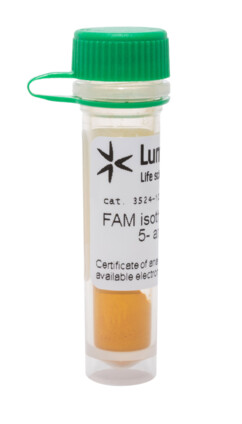DAPI, blue fluorescent nucleic acid stain
| Cat. # | Quantity | Price | Lead time | Buy this product |
|---|---|---|---|---|
| 2996-1mL | 1 mL, 1 mg/mL in Water |
$75
|
in stock | |
| 2996-50uL | 50 uL, 1 mg/mL in Water |
–
|
in stock | |
| 2996-1mg | 1 mg |
$30
|
in stock | |
| 2996-10mg | 10 mg |
$110
|
in stock |

DAPI (4′,6-diamidino-2-phenylindole) is a blue-emitting fluorescent dye that binds strongly to adenine-thymine-rich regions in DNA. It is used extensively in fluorescence microscopy, flow cytometry for chromosome staining and as a nuclear counterstain. DAPI is generally used to stain fixed cells since the dye is membrane impermeant, although the dye can enter live cells when used at high concentrations.
When bound to double-stranded DNA, DAPI exhibits ~20-fold enhancement of fluorescence with an absorption maximum at 355 nm and emission maximum at 460 nm. DAPI also binds to RNA, though it is not as strongly fluorescent. When bound to RNA, its emission spectrum shifts to around 500 nm.
There is a slight fluorescence overlap between DAPI and green-fluorescent molecules like fluorescein and GFP. Use spectral unmixing if extremely precise image analysis is required.
DAPI is several times more sensitive than ethidium bromide for staining DNA in agarose gels. It may be used for photofootprinting DNA and detecting annealed probes in blotting applications by specifically visualizing the double-stranded complex. Also, DAPI staining is a sensitive and specific detection method for mycoplasma.
The working concentration of DAPI for staining eukaryotic cells is usually 1 μg/mL. Still, it depends on the cell type and density, so the exact dilution of the dye should be determined experimentally.
Product in action
Absorption and emission spectra of DAPI

Help center
Customers also purchased with this product
General properties
| Appearance: | yellow solid / solution |
| Molecular weight: | 350.25 |
| CAS number: | 28718-90-3 |
| Molecular formula: | C16H17Cl2N5 |
| Solubility: | good in DMF, DMSO |
| Quality control: | NMR 1H and HPLC-MS (95+%) |
| Storage conditions: | 24 months after receival at -20°C in the dark. Transportation: at room temperature for up to 3 weeks. Desiccate. |
| MSDS: | Download |
| Product specifications |
Spectral properties
| Excitation/absorption maximum, nm: | 355 |
| ε, L⋅mol−1⋅cm−1: | 28800 |
| Emission maximum, nm: | 460 |
Product citations
- Samatoshenkov, I.V.; Aimaletdinov, A.M.; Zakirova, E.Y.; Chelyshev, Y.A.; Samatoshenkova, J.M.; Kadyrov, M.S.; Kniazev, E.A.; Salakhov, B.I.; Mukhamedshina, Y.O. The Combined Delivery of the Vegf, Ang, and Gdnf Genes Stimulates Angiogenesis and Improves Post-Ischemic Innervation and Regeneration in Skeletal Muscle. Current Issues in Molecular Biology, 2024, 46(8), 8611-8626. doi: 10.3390/cimb46080507
- Potapenko, E.Y..; Kashko, N.D.; Knorre, D.A. Spontaneous Mutations in Saccharomyces cerevisiae mtDNA Increase Cell-to-Cell Variation in mtDNA Amount. International Journal of Molecular Sciences, 2023, 24(24), 17413. doi: 10.3390/ijms242417413


























 $
$ 
